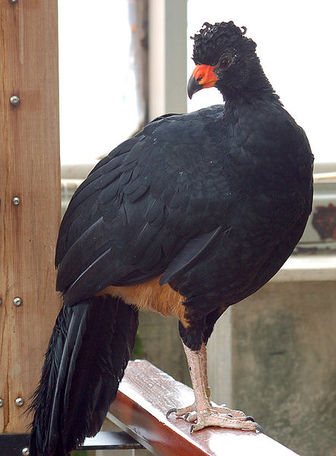Wattled Curassow
The Wattled Curassow is a threatened member of the family Cracidae, the curassows, guans, and chachalacas. It is found in remote rainforests in the western Amazon Basin in South America.

The Wattled Curassow is classified as Vulnerable (VU), considered to be facing a high risk of extinction in the wild.
The Wattled Curassow (Crax globulosa) is a threatened member of the family Cracidae, the curassows, guans, and chachalacas. It is found in remote rainforests in the western Amazon Basin in South America. Contents - * 1 Description * 1. More
The wattled curassow has a soft whistle, "yeeeeeee," which lasts four to six seconds. FEEDING ECOLOGY AND DIET Not known. REPRODUCTIVE BIOLOGY No information available about breeding in the wild. In captivity, clutch size is two eggs; chicks brownish above, light buff below. CONSERVATION STATUS Vulnerable. The wattled curassow is rarely encountered, and very patchily distributed throughout its geographic range in the western Amazonian basin. More
The wattled curassow is widespread in the Andean lowlands and Amazon basin, but its range and abundance have dramatically declined in recent years, with small, scattered, fragmented populations now remaining only in west Brazil, south Colombia, east Ecuador, east Peru and north Bolivia, (2) (5). It has been speculated that the Ecuador population is probably now extinct, while fewer than 300 individuals are thought to persist in Bolivia, fewer than 300 in Peru, and possible fewer than 100 in Colombia. More
The Wattled curassow's range consists of Upper Amazonia from southeastern Columbia south along the eastern foothills of the Andes through Ecuador and Peru to northeastern Bolivia. They inhabit somewhat dry areas in the tropical Amazonian forest, staying away from swampy places. Curassows in general are about the size of a wild turkey, averaging 7 - 8 lbs. (3.5 kg). Their diet consists of fruits and greens. The captive diet is similar with chopped fruit, greens and seeds. More
The Wattled Curassow (Crax globulosa) is the least known of the curassows that occur in the Colombian Amazon, and there is no protected area in the country with a confirmed population of the species. This note is intended as a first step in addressing the apparent dearth of hard data about its status and regional biology. More
'Monitoring the Wattled Curassow (Crax globulosa), in Bolivia' Objectives and background Project gallery - Prev. Next Objective To provide the tools and training needed for the implementation of a Wattled Curassow environmental programme in the Tacana III Indigenious territory. Background The Wattled Curassow (Crax globulosa) was rediscovered in Bolivia in 1998 after it was thought extinct from the country. More
The wattled curassow (Crax globulosa) is a large bird, about the size of a turkey. Its most prominent feature is a well-developed curly crest of head feathers. It is mostly black with white tail feathers underneath black tail feathers (coverts). The bill is black, with an orange to red knob that extends down to form a hanging wattle. It signals with a high-pitched call. There are about 12 kinds of curassows found in Amazonia. More
vues stormycat9 — 3 septembre 2008 — A wattled curassow in the wetlands display at the National Aviary in Pittsburgh, PA stormycat9 — 3 septembre 2008 — A wattled curassow in the wetlands display at the National Aviary in Pittsburgh, PACatégorie : Animaux Tags :National Aviary wattled curassow Pittsburgh Chargement… J'aime Enregistrer dans Partager E-mail Skyrock Facebook Twitter MySpace Live Spaces Blogger orkut Buzz reddit Digg Chargement… Connectez-vous ou inscrivez-vous dès maintenant ! Publier un commentaire * 16and30 il More
The Wattled Curassow (Crax globulosa) is a member of the Cracidae family, the curassows, guans, and chachalacas. Overview - The Wattled Curassow is rarely found in the wild, and classified as a vulnerable species due to unsustainable hunting and habitat destruction. It is 82-89 cm (c.32-35 inches) long, and weighs up to 2500 grams (del Hoyo 1994). More
The wattled curassow was another floor-dweller, and spent most of its time at the Discovery Cove aviary trying not to be seen. I caught it on a lucky break out in the open.\n\nThis is one of the great things about the Discovery Cove aviary. You don't have to pay for a tour to South America or Asia or Africa and hope you get lucky enough to see a bird like this. And this close, too. And you'll get to feed it. More
Geographic range: The wattled curassow is found from Colombia and western Brazil to Bolivia. Habitat: This bird prefers the tropical rainfor-est in the Amazon basin. It rarely leaves the trees except to breed.. Diet: Wattled currasows feed on vegetation and small invertebrates (animals without backbones). Behavior and reproduction: The wattled curas-sow whistles softly for four to six seconds at a time. Nothing is known about this bird's repro-ductive habits in the wild. More
they came face to face with the Wattled Curassow in the Amazonian lowlands, and the Horned Curassow in the Andean foothills. The Wattled Curassow was found at Hugo's main study site after a 5-hour boat trip down the R More

Original source: Emijrpbot
Author: Emijrpbot
Permission: Some rights reserved

